Global Marketing and Digital Business Report: Travelodge Strategy
VerifiedAdded on 2023/01/13
|11
|3292
|29
Report
AI Summary
This report provides a comprehensive analysis of Travelodge's global marketing and digital business strategies. It begins with an introduction to Travelodge, outlining its background, services, and the aims of the marketing plan. The report then delves into industry analysis, examining competitors and key findings. A situational analysis, including external and internal factors (SWOT), is presented, followed by an exploration of relevant models and theories, such as the Uppsala Internationalization Model, Porter's Diamond, and cultural factors. The report further examines marketing activities, including segmentation, targeting, positioning, and branding, alongside online activities. Finally, it offers recommendations and a conclusion, summarizing the key findings and strategic implications for Travelodge's global expansion, particularly its entry into the Spanish market.
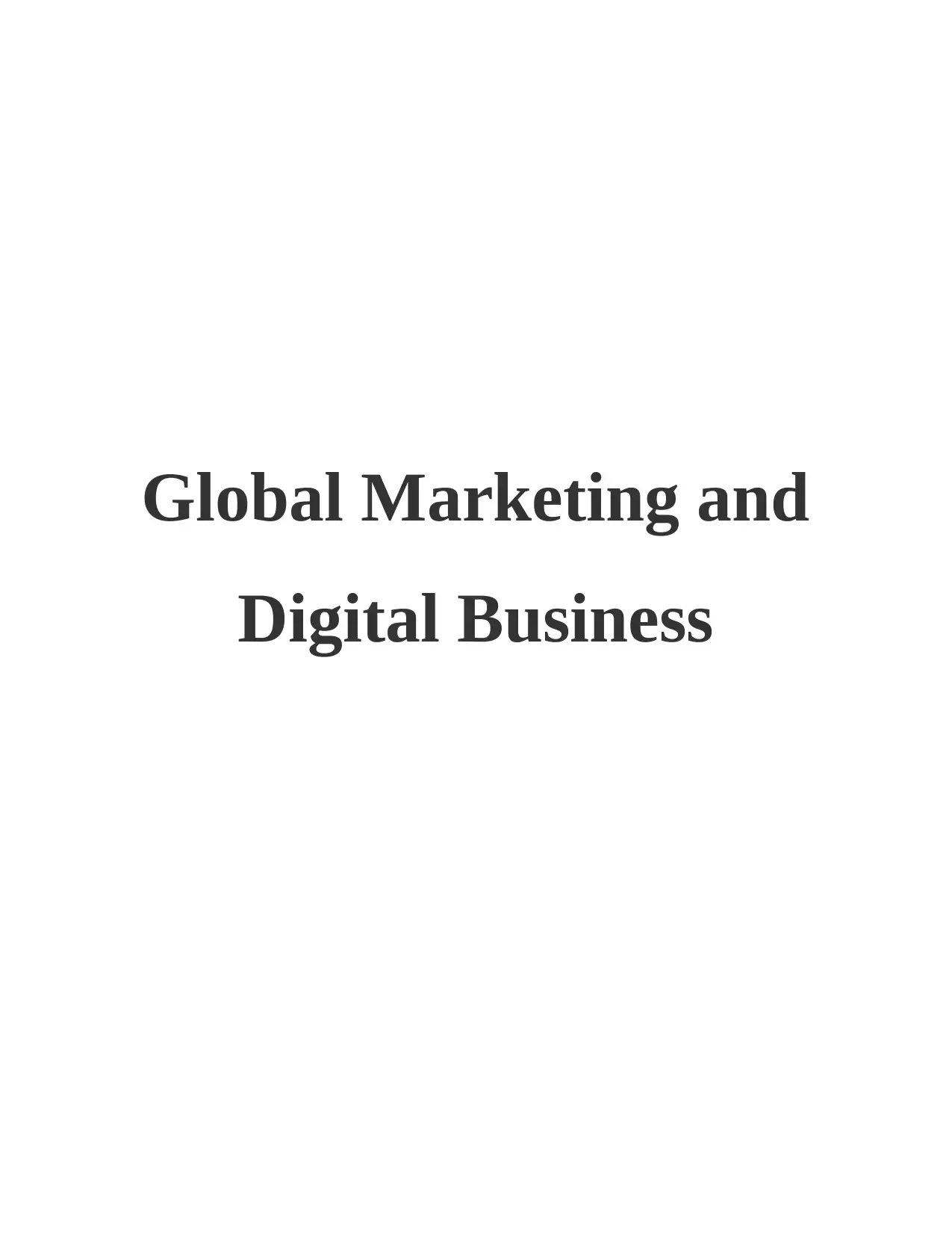
Global Marketing and
Digital Business
Digital Business
Paraphrase This Document
Need a fresh take? Get an instant paraphrase of this document with our AI Paraphraser
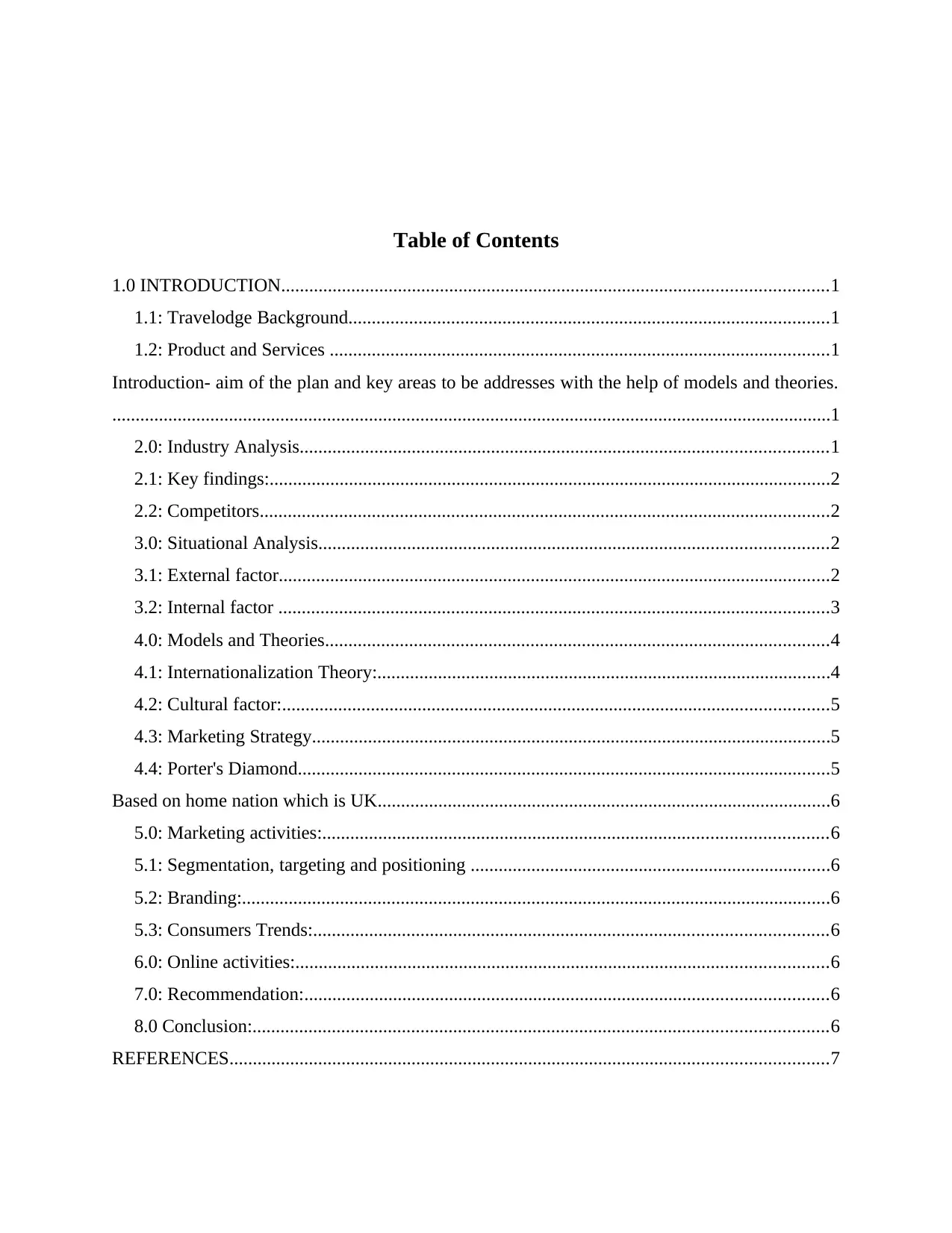
Table of Contents
1.0 INTRODUCTION.....................................................................................................................1
1.1: Travelodge Background.......................................................................................................1
1.2: Product and Services ...........................................................................................................1
Introduction- aim of the plan and key areas to be addresses with the help of models and theories.
..........................................................................................................................................................1
2.0: Industry Analysis.................................................................................................................1
2.1: Key findings:........................................................................................................................2
2.2: Competitors..........................................................................................................................2
3.0: Situational Analysis.............................................................................................................2
3.1: External factor......................................................................................................................2
3.2: Internal factor ......................................................................................................................3
4.0: Models and Theories............................................................................................................4
4.1: Internationalization Theory:.................................................................................................4
4.2: Cultural factor:.....................................................................................................................5
4.3: Marketing Strategy...............................................................................................................5
4.4: Porter's Diamond..................................................................................................................5
Based on home nation which is UK.................................................................................................6
5.0: Marketing activities:............................................................................................................6
5.1: Segmentation, targeting and positioning .............................................................................6
5.2: Branding:..............................................................................................................................6
5.3: Consumers Trends:..............................................................................................................6
6.0: Online activities:..................................................................................................................6
7.0: Recommendation:................................................................................................................6
8.0 Conclusion:...........................................................................................................................6
REFERENCES................................................................................................................................7
1.0 INTRODUCTION.....................................................................................................................1
1.1: Travelodge Background.......................................................................................................1
1.2: Product and Services ...........................................................................................................1
Introduction- aim of the plan and key areas to be addresses with the help of models and theories.
..........................................................................................................................................................1
2.0: Industry Analysis.................................................................................................................1
2.1: Key findings:........................................................................................................................2
2.2: Competitors..........................................................................................................................2
3.0: Situational Analysis.............................................................................................................2
3.1: External factor......................................................................................................................2
3.2: Internal factor ......................................................................................................................3
4.0: Models and Theories............................................................................................................4
4.1: Internationalization Theory:.................................................................................................4
4.2: Cultural factor:.....................................................................................................................5
4.3: Marketing Strategy...............................................................................................................5
4.4: Porter's Diamond..................................................................................................................5
Based on home nation which is UK.................................................................................................6
5.0: Marketing activities:............................................................................................................6
5.1: Segmentation, targeting and positioning .............................................................................6
5.2: Branding:..............................................................................................................................6
5.3: Consumers Trends:..............................................................................................................6
6.0: Online activities:..................................................................................................................6
7.0: Recommendation:................................................................................................................6
8.0 Conclusion:...........................................................................................................................6
REFERENCES................................................................................................................................7
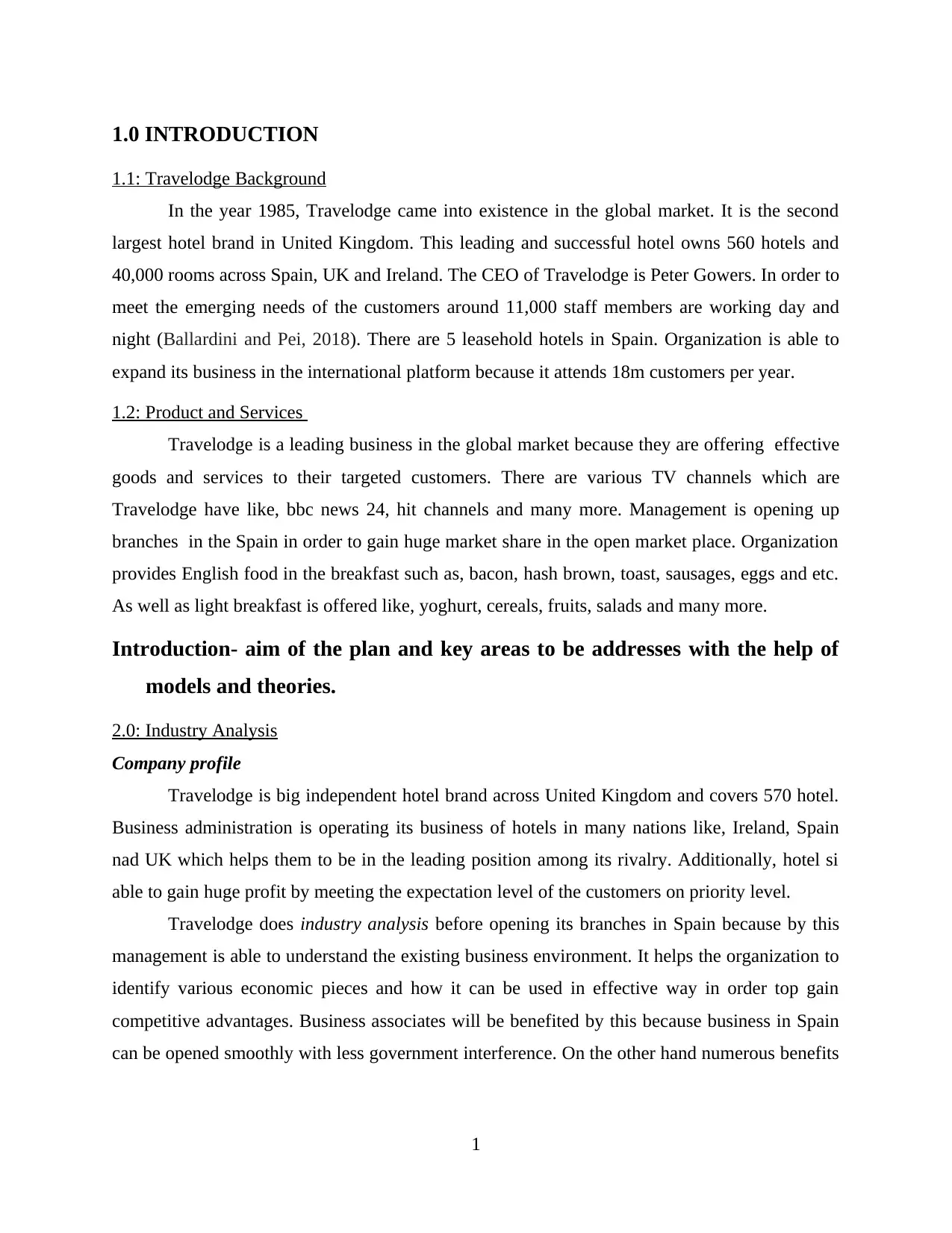
1.0 INTRODUCTION
1.1: Travelodge Background
In the year 1985, Travelodge came into existence in the global market. It is the second
largest hotel brand in United Kingdom. This leading and successful hotel owns 560 hotels and
40,000 rooms across Spain, UK and Ireland. The CEO of Travelodge is Peter Gowers. In order to
meet the emerging needs of the customers around 11,000 staff members are working day and
night (Ballardini and Pei, 2018). There are 5 leasehold hotels in Spain. Organization is able to
expand its business in the international platform because it attends 18m customers per year.
1.2: Product and Services
Travelodge is a leading business in the global market because they are offering effective
goods and services to their targeted customers. There are various TV channels which are
Travelodge have like, bbc news 24, hit channels and many more. Management is opening up
branches in the Spain in order to gain huge market share in the open market place. Organization
provides English food in the breakfast such as, bacon, hash brown, toast, sausages, eggs and etc.
As well as light breakfast is offered like, yoghurt, cereals, fruits, salads and many more.
Introduction- aim of the plan and key areas to be addresses with the help of
models and theories.
2.0: Industry Analysis
Company profile
Travelodge is big independent hotel brand across United Kingdom and covers 570 hotel.
Business administration is operating its business of hotels in many nations like, Ireland, Spain
nad UK which helps them to be in the leading position among its rivalry. Additionally, hotel si
able to gain huge profit by meeting the expectation level of the customers on priority level.
Travelodge does industry analysis before opening its branches in Spain because by this
management is able to understand the existing business environment. It helps the organization to
identify various economic pieces and how it can be used in effective way in order top gain
competitive advantages. Business associates will be benefited by this because business in Spain
can be opened smoothly with less government interference. On the other hand numerous benefits
1
1.1: Travelodge Background
In the year 1985, Travelodge came into existence in the global market. It is the second
largest hotel brand in United Kingdom. This leading and successful hotel owns 560 hotels and
40,000 rooms across Spain, UK and Ireland. The CEO of Travelodge is Peter Gowers. In order to
meet the emerging needs of the customers around 11,000 staff members are working day and
night (Ballardini and Pei, 2018). There are 5 leasehold hotels in Spain. Organization is able to
expand its business in the international platform because it attends 18m customers per year.
1.2: Product and Services
Travelodge is a leading business in the global market because they are offering effective
goods and services to their targeted customers. There are various TV channels which are
Travelodge have like, bbc news 24, hit channels and many more. Management is opening up
branches in the Spain in order to gain huge market share in the open market place. Organization
provides English food in the breakfast such as, bacon, hash brown, toast, sausages, eggs and etc.
As well as light breakfast is offered like, yoghurt, cereals, fruits, salads and many more.
Introduction- aim of the plan and key areas to be addresses with the help of
models and theories.
2.0: Industry Analysis
Company profile
Travelodge is big independent hotel brand across United Kingdom and covers 570 hotel.
Business administration is operating its business of hotels in many nations like, Ireland, Spain
nad UK which helps them to be in the leading position among its rivalry. Additionally, hotel si
able to gain huge profit by meeting the expectation level of the customers on priority level.
Travelodge does industry analysis before opening its branches in Spain because by this
management is able to understand the existing business environment. It helps the organization to
identify various economic pieces and how it can be used in effective way in order top gain
competitive advantages. Business associates will be benefited by this because business in Spain
can be opened smoothly with less government interference. On the other hand numerous benefits
1
⊘ This is a preview!⊘
Do you want full access?
Subscribe today to unlock all pages.

Trusted by 1+ million students worldwide
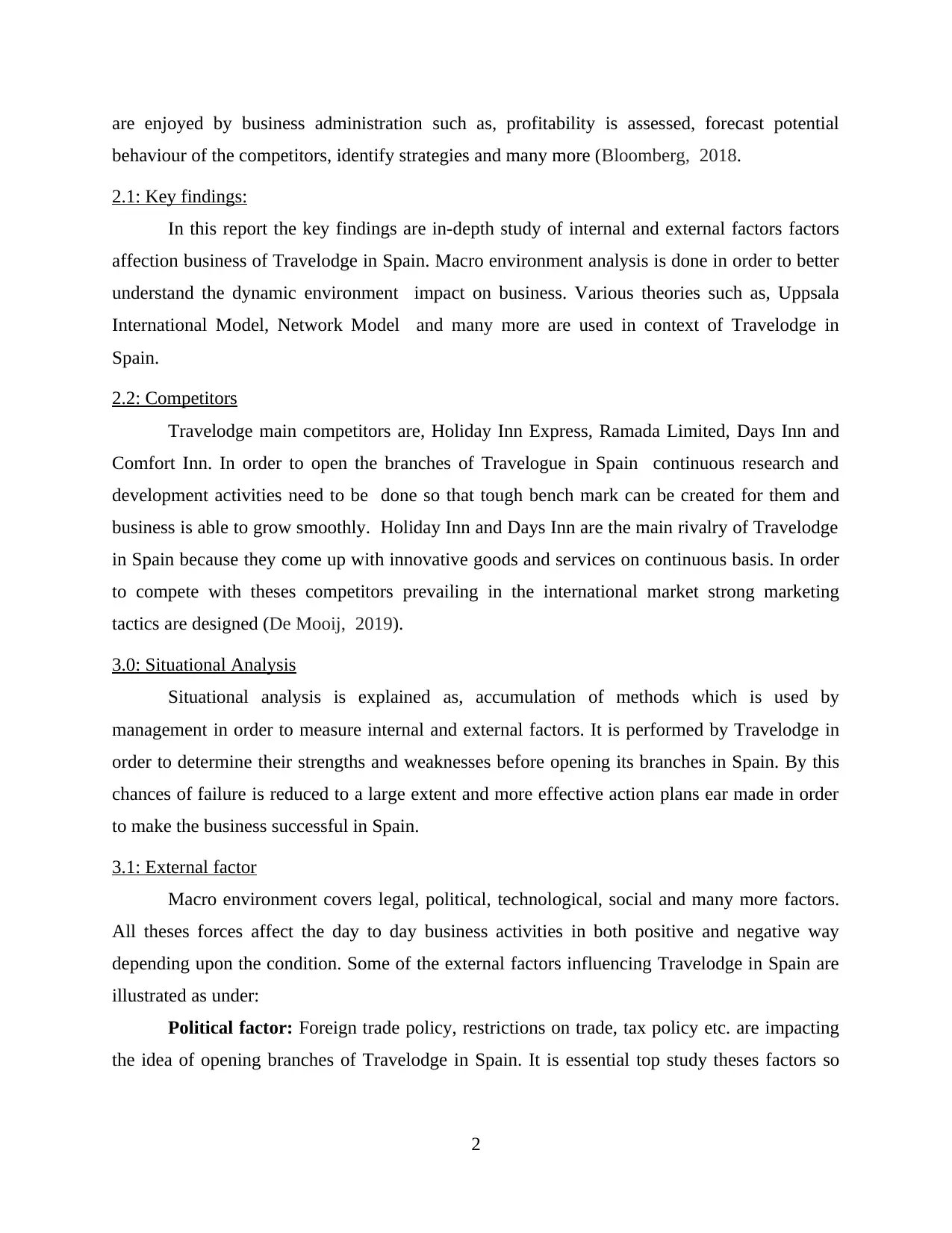
are enjoyed by business administration such as, profitability is assessed, forecast potential
behaviour of the competitors, identify strategies and many more (Bloomberg, 2018.
2.1: Key findings:
In this report the key findings are in-depth study of internal and external factors factors
affection business of Travelodge in Spain. Macro environment analysis is done in order to better
understand the dynamic environment impact on business. Various theories such as, Uppsala
International Model, Network Model and many more are used in context of Travelodge in
Spain.
2.2: Competitors
Travelodge main competitors are, Holiday Inn Express, Ramada Limited, Days Inn and
Comfort Inn. In order to open the branches of Travelogue in Spain continuous research and
development activities need to be done so that tough bench mark can be created for them and
business is able to grow smoothly. Holiday Inn and Days Inn are the main rivalry of Travelodge
in Spain because they come up with innovative goods and services on continuous basis. In order
to compete with theses competitors prevailing in the international market strong marketing
tactics are designed (De Mooij, 2019).
3.0: Situational Analysis
Situational analysis is explained as, accumulation of methods which is used by
management in order to measure internal and external factors. It is performed by Travelodge in
order to determine their strengths and weaknesses before opening its branches in Spain. By this
chances of failure is reduced to a large extent and more effective action plans ear made in order
to make the business successful in Spain.
3.1: External factor
Macro environment covers legal, political, technological, social and many more factors.
All theses forces affect the day to day business activities in both positive and negative way
depending upon the condition. Some of the external factors influencing Travelodge in Spain are
illustrated as under:
Political factor: Foreign trade policy, restrictions on trade, tax policy etc. are impacting
the idea of opening branches of Travelodge in Spain. It is essential top study theses factors so
2
behaviour of the competitors, identify strategies and many more (Bloomberg, 2018.
2.1: Key findings:
In this report the key findings are in-depth study of internal and external factors factors
affection business of Travelodge in Spain. Macro environment analysis is done in order to better
understand the dynamic environment impact on business. Various theories such as, Uppsala
International Model, Network Model and many more are used in context of Travelodge in
Spain.
2.2: Competitors
Travelodge main competitors are, Holiday Inn Express, Ramada Limited, Days Inn and
Comfort Inn. In order to open the branches of Travelogue in Spain continuous research and
development activities need to be done so that tough bench mark can be created for them and
business is able to grow smoothly. Holiday Inn and Days Inn are the main rivalry of Travelodge
in Spain because they come up with innovative goods and services on continuous basis. In order
to compete with theses competitors prevailing in the international market strong marketing
tactics are designed (De Mooij, 2019).
3.0: Situational Analysis
Situational analysis is explained as, accumulation of methods which is used by
management in order to measure internal and external factors. It is performed by Travelodge in
order to determine their strengths and weaknesses before opening its branches in Spain. By this
chances of failure is reduced to a large extent and more effective action plans ear made in order
to make the business successful in Spain.
3.1: External factor
Macro environment covers legal, political, technological, social and many more factors.
All theses forces affect the day to day business activities in both positive and negative way
depending upon the condition. Some of the external factors influencing Travelodge in Spain are
illustrated as under:
Political factor: Foreign trade policy, restrictions on trade, tax policy etc. are impacting
the idea of opening branches of Travelodge in Spain. It is essential top study theses factors so
2
Paraphrase This Document
Need a fresh take? Get an instant paraphrase of this document with our AI Paraphraser
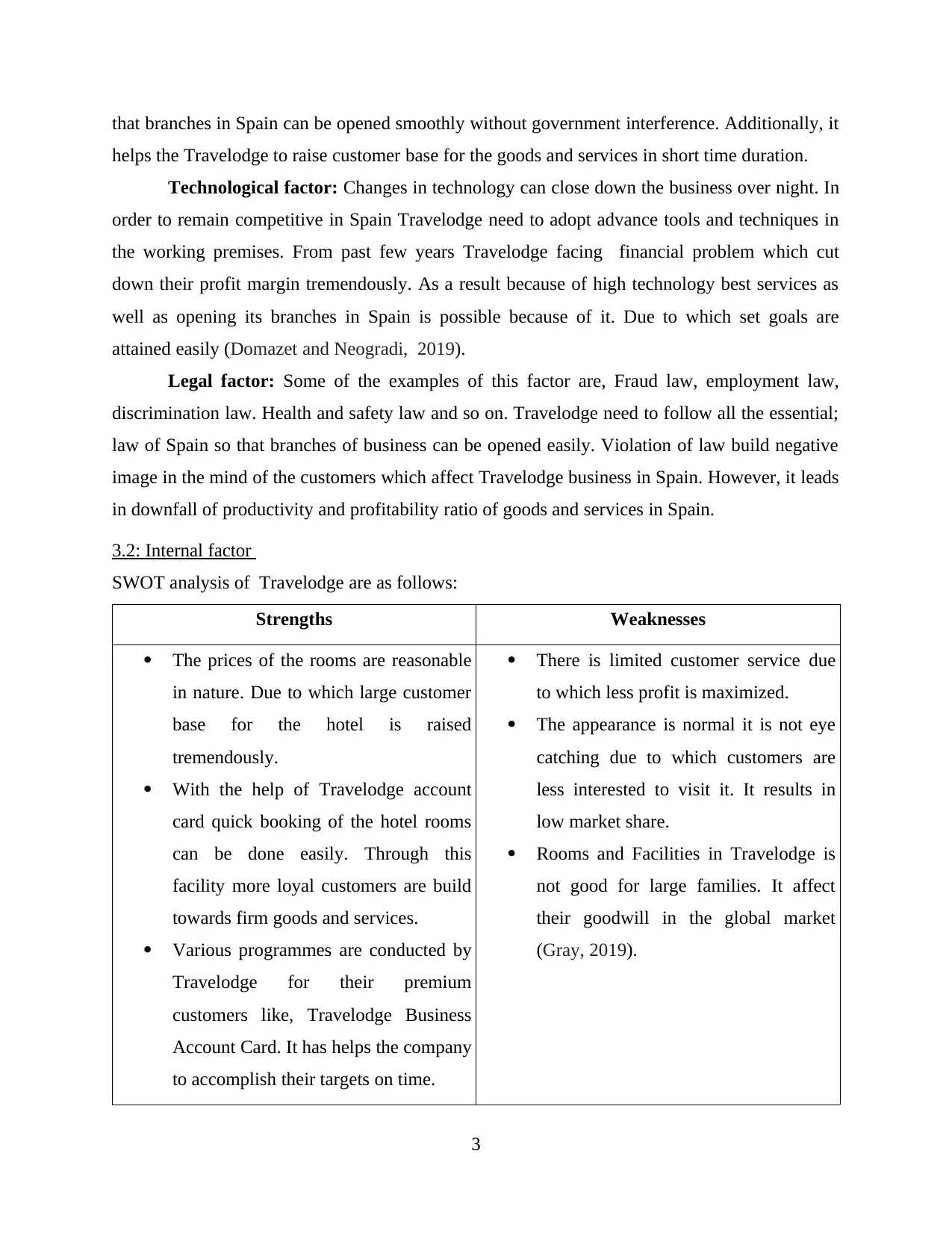
that branches in Spain can be opened smoothly without government interference. Additionally, it
helps the Travelodge to raise customer base for the goods and services in short time duration.
Technological factor: Changes in technology can close down the business over night. In
order to remain competitive in Spain Travelodge need to adopt advance tools and techniques in
the working premises. From past few years Travelodge facing financial problem which cut
down their profit margin tremendously. As a result because of high technology best services as
well as opening its branches in Spain is possible because of it. Due to which set goals are
attained easily (Domazet and Neogradi, 2019).
Legal factor: Some of the examples of this factor are, Fraud law, employment law,
discrimination law. Health and safety law and so on. Travelodge need to follow all the essential;
law of Spain so that branches of business can be opened easily. Violation of law build negative
image in the mind of the customers which affect Travelodge business in Spain. However, it leads
in downfall of productivity and profitability ratio of goods and services in Spain.
3.2: Internal factor
SWOT analysis of Travelodge are as follows:
Strengths Weaknesses
The prices of the rooms are reasonable
in nature. Due to which large customer
base for the hotel is raised
tremendously.
With the help of Travelodge account
card quick booking of the hotel rooms
can be done easily. Through this
facility more loyal customers are build
towards firm goods and services.
Various programmes are conducted by
Travelodge for their premium
customers like, Travelodge Business
Account Card. It has helps the company
to accomplish their targets on time.
There is limited customer service due
to which less profit is maximized.
The appearance is normal it is not eye
catching due to which customers are
less interested to visit it. It results in
low market share.
Rooms and Facilities in Travelodge is
not good for large families. It affect
their goodwill in the global market
(Gray, 2019).
3
helps the Travelodge to raise customer base for the goods and services in short time duration.
Technological factor: Changes in technology can close down the business over night. In
order to remain competitive in Spain Travelodge need to adopt advance tools and techniques in
the working premises. From past few years Travelodge facing financial problem which cut
down their profit margin tremendously. As a result because of high technology best services as
well as opening its branches in Spain is possible because of it. Due to which set goals are
attained easily (Domazet and Neogradi, 2019).
Legal factor: Some of the examples of this factor are, Fraud law, employment law,
discrimination law. Health and safety law and so on. Travelodge need to follow all the essential;
law of Spain so that branches of business can be opened easily. Violation of law build negative
image in the mind of the customers which affect Travelodge business in Spain. However, it leads
in downfall of productivity and profitability ratio of goods and services in Spain.
3.2: Internal factor
SWOT analysis of Travelodge are as follows:
Strengths Weaknesses
The prices of the rooms are reasonable
in nature. Due to which large customer
base for the hotel is raised
tremendously.
With the help of Travelodge account
card quick booking of the hotel rooms
can be done easily. Through this
facility more loyal customers are build
towards firm goods and services.
Various programmes are conducted by
Travelodge for their premium
customers like, Travelodge Business
Account Card. It has helps the company
to accomplish their targets on time.
There is limited customer service due
to which less profit is maximized.
The appearance is normal it is not eye
catching due to which customers are
less interested to visit it. It results in
low market share.
Rooms and Facilities in Travelodge is
not good for large families. It affect
their goodwill in the global market
(Gray, 2019).
3
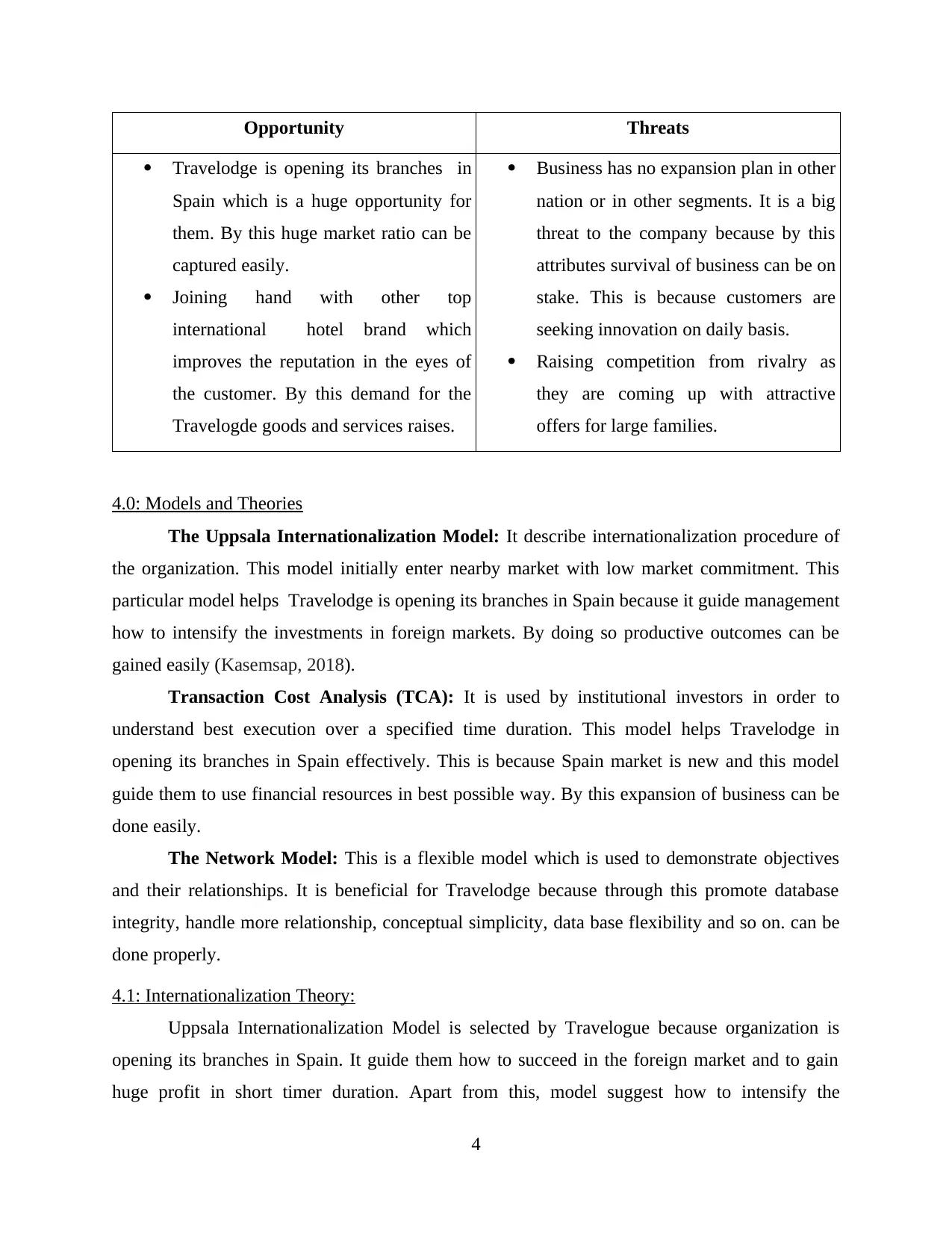
Opportunity Threats
Travelodge is opening its branches in
Spain which is a huge opportunity for
them. By this huge market ratio can be
captured easily.
Joining hand with other top
international hotel brand which
improves the reputation in the eyes of
the customer. By this demand for the
Travelogde goods and services raises.
Business has no expansion plan in other
nation or in other segments. It is a big
threat to the company because by this
attributes survival of business can be on
stake. This is because customers are
seeking innovation on daily basis.
Raising competition from rivalry as
they are coming up with attractive
offers for large families.
4.0: Models and Theories
The Uppsala Internationalization Model: It describe internationalization procedure of
the organization. This model initially enter nearby market with low market commitment. This
particular model helps Travelodge is opening its branches in Spain because it guide management
how to intensify the investments in foreign markets. By doing so productive outcomes can be
gained easily (Kasemsap, 2018).
Transaction Cost Analysis (TCA): It is used by institutional investors in order to
understand best execution over a specified time duration. This model helps Travelodge in
opening its branches in Spain effectively. This is because Spain market is new and this model
guide them to use financial resources in best possible way. By this expansion of business can be
done easily.
The Network Model: This is a flexible model which is used to demonstrate objectives
and their relationships. It is beneficial for Travelodge because through this promote database
integrity, handle more relationship, conceptual simplicity, data base flexibility and so on. can be
done properly.
4.1: Internationalization Theory:
Uppsala Internationalization Model is selected by Travelogue because organization is
opening its branches in Spain. It guide them how to succeed in the foreign market and to gain
huge profit in short timer duration. Apart from this, model suggest how to intensify the
4
Travelodge is opening its branches in
Spain which is a huge opportunity for
them. By this huge market ratio can be
captured easily.
Joining hand with other top
international hotel brand which
improves the reputation in the eyes of
the customer. By this demand for the
Travelogde goods and services raises.
Business has no expansion plan in other
nation or in other segments. It is a big
threat to the company because by this
attributes survival of business can be on
stake. This is because customers are
seeking innovation on daily basis.
Raising competition from rivalry as
they are coming up with attractive
offers for large families.
4.0: Models and Theories
The Uppsala Internationalization Model: It describe internationalization procedure of
the organization. This model initially enter nearby market with low market commitment. This
particular model helps Travelodge is opening its branches in Spain because it guide management
how to intensify the investments in foreign markets. By doing so productive outcomes can be
gained easily (Kasemsap, 2018).
Transaction Cost Analysis (TCA): It is used by institutional investors in order to
understand best execution over a specified time duration. This model helps Travelodge in
opening its branches in Spain effectively. This is because Spain market is new and this model
guide them to use financial resources in best possible way. By this expansion of business can be
done easily.
The Network Model: This is a flexible model which is used to demonstrate objectives
and their relationships. It is beneficial for Travelodge because through this promote database
integrity, handle more relationship, conceptual simplicity, data base flexibility and so on. can be
done properly.
4.1: Internationalization Theory:
Uppsala Internationalization Model is selected by Travelogue because organization is
opening its branches in Spain. It guide them how to succeed in the foreign market and to gain
huge profit in short timer duration. Apart from this, model suggest how to intensify the
4
⊘ This is a preview!⊘
Do you want full access?
Subscribe today to unlock all pages.

Trusted by 1+ million students worldwide
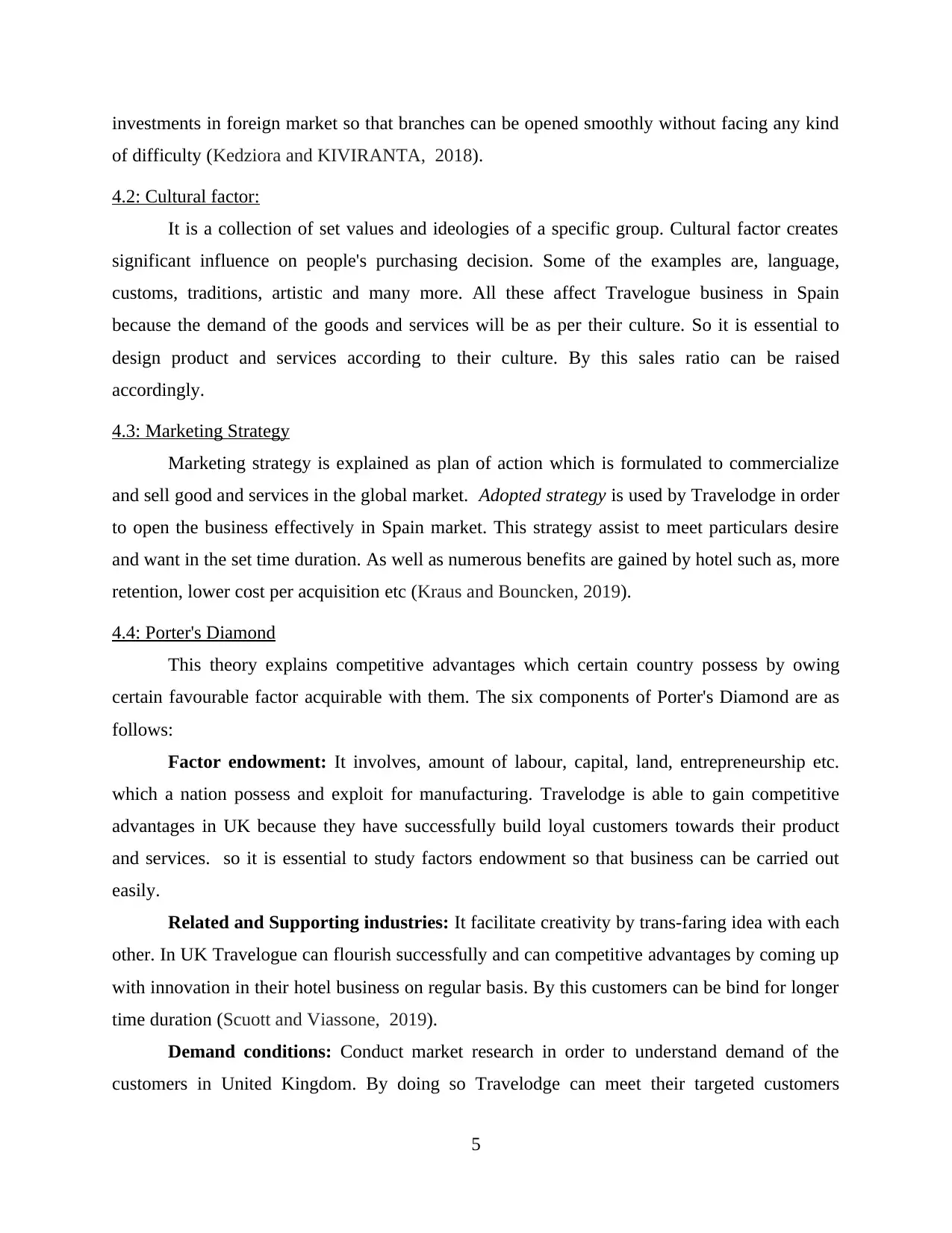
investments in foreign market so that branches can be opened smoothly without facing any kind
of difficulty (Kedziora and KIVIRANTA, 2018).
4.2: Cultural factor:
It is a collection of set values and ideologies of a specific group. Cultural factor creates
significant influence on people's purchasing decision. Some of the examples are, language,
customs, traditions, artistic and many more. All these affect Travelogue business in Spain
because the demand of the goods and services will be as per their culture. So it is essential to
design product and services according to their culture. By this sales ratio can be raised
accordingly.
4.3: Marketing Strategy
Marketing strategy is explained as plan of action which is formulated to commercialize
and sell good and services in the global market. Adopted strategy is used by Travelodge in order
to open the business effectively in Spain market. This strategy assist to meet particulars desire
and want in the set time duration. As well as numerous benefits are gained by hotel such as, more
retention, lower cost per acquisition etc (Kraus and Bouncken, 2019).
4.4: Porter's Diamond
This theory explains competitive advantages which certain country possess by owing
certain favourable factor acquirable with them. The six components of Porter's Diamond are as
follows:
Factor endowment: It involves, amount of labour, capital, land, entrepreneurship etc.
which a nation possess and exploit for manufacturing. Travelodge is able to gain competitive
advantages in UK because they have successfully build loyal customers towards their product
and services. so it is essential to study factors endowment so that business can be carried out
easily.
Related and Supporting industries: It facilitate creativity by trans-faring idea with each
other. In UK Travelogue can flourish successfully and can competitive advantages by coming up
with innovation in their hotel business on regular basis. By this customers can be bind for longer
time duration (Scuott and Viassone, 2019).
Demand conditions: Conduct market research in order to understand demand of the
customers in United Kingdom. By doing so Travelodge can meet their targeted customers
5
of difficulty (Kedziora and KIVIRANTA, 2018).
4.2: Cultural factor:
It is a collection of set values and ideologies of a specific group. Cultural factor creates
significant influence on people's purchasing decision. Some of the examples are, language,
customs, traditions, artistic and many more. All these affect Travelogue business in Spain
because the demand of the goods and services will be as per their culture. So it is essential to
design product and services according to their culture. By this sales ratio can be raised
accordingly.
4.3: Marketing Strategy
Marketing strategy is explained as plan of action which is formulated to commercialize
and sell good and services in the global market. Adopted strategy is used by Travelodge in order
to open the business effectively in Spain market. This strategy assist to meet particulars desire
and want in the set time duration. As well as numerous benefits are gained by hotel such as, more
retention, lower cost per acquisition etc (Kraus and Bouncken, 2019).
4.4: Porter's Diamond
This theory explains competitive advantages which certain country possess by owing
certain favourable factor acquirable with them. The six components of Porter's Diamond are as
follows:
Factor endowment: It involves, amount of labour, capital, land, entrepreneurship etc.
which a nation possess and exploit for manufacturing. Travelodge is able to gain competitive
advantages in UK because they have successfully build loyal customers towards their product
and services. so it is essential to study factors endowment so that business can be carried out
easily.
Related and Supporting industries: It facilitate creativity by trans-faring idea with each
other. In UK Travelogue can flourish successfully and can competitive advantages by coming up
with innovation in their hotel business on regular basis. By this customers can be bind for longer
time duration (Scuott and Viassone, 2019).
Demand conditions: Conduct market research in order to understand demand of the
customers in United Kingdom. By doing so Travelodge can meet their targeted customers
5
Paraphrase This Document
Need a fresh take? Get an instant paraphrase of this document with our AI Paraphraser
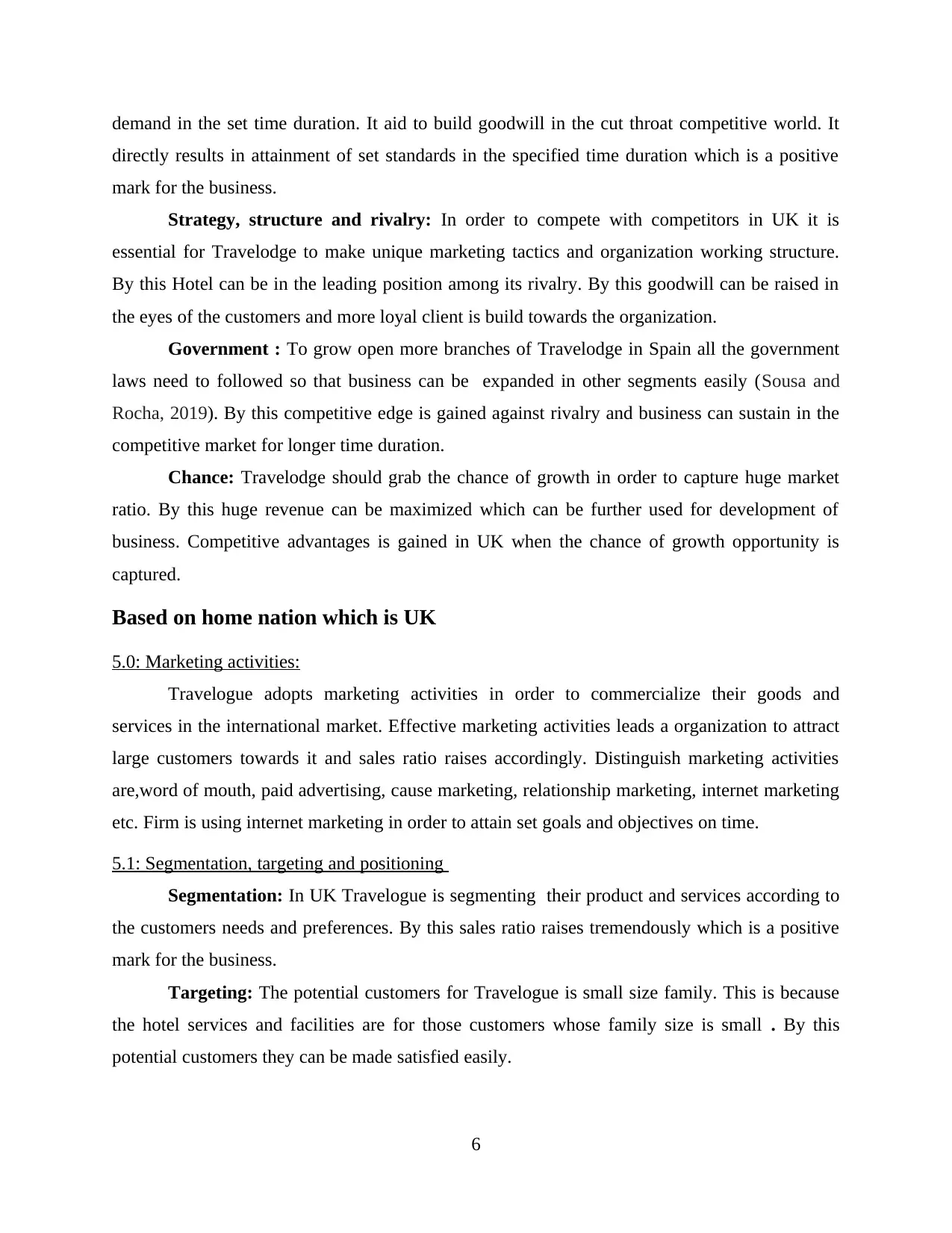
demand in the set time duration. It aid to build goodwill in the cut throat competitive world. It
directly results in attainment of set standards in the specified time duration which is a positive
mark for the business.
Strategy, structure and rivalry: In order to compete with competitors in UK it is
essential for Travelodge to make unique marketing tactics and organization working structure.
By this Hotel can be in the leading position among its rivalry. By this goodwill can be raised in
the eyes of the customers and more loyal client is build towards the organization.
Government : To grow open more branches of Travelodge in Spain all the government
laws need to followed so that business can be expanded in other segments easily (Sousa and
Rocha, 2019). By this competitive edge is gained against rivalry and business can sustain in the
competitive market for longer time duration.
Chance: Travelodge should grab the chance of growth in order to capture huge market
ratio. By this huge revenue can be maximized which can be further used for development of
business. Competitive advantages is gained in UK when the chance of growth opportunity is
captured.
Based on home nation which is UK
5.0: Marketing activities:
Travelogue adopts marketing activities in order to commercialize their goods and
services in the international market. Effective marketing activities leads a organization to attract
large customers towards it and sales ratio raises accordingly. Distinguish marketing activities
are,word of mouth, paid advertising, cause marketing, relationship marketing, internet marketing
etc. Firm is using internet marketing in order to attain set goals and objectives on time.
5.1: Segmentation, targeting and positioning
Segmentation: In UK Travelogue is segmenting their product and services according to
the customers needs and preferences. By this sales ratio raises tremendously which is a positive
mark for the business.
Targeting: The potential customers for Travelogue is small size family. This is because
the hotel services and facilities are for those customers whose family size is small . By this
potential customers they can be made satisfied easily.
6
directly results in attainment of set standards in the specified time duration which is a positive
mark for the business.
Strategy, structure and rivalry: In order to compete with competitors in UK it is
essential for Travelodge to make unique marketing tactics and organization working structure.
By this Hotel can be in the leading position among its rivalry. By this goodwill can be raised in
the eyes of the customers and more loyal client is build towards the organization.
Government : To grow open more branches of Travelodge in Spain all the government
laws need to followed so that business can be expanded in other segments easily (Sousa and
Rocha, 2019). By this competitive edge is gained against rivalry and business can sustain in the
competitive market for longer time duration.
Chance: Travelodge should grab the chance of growth in order to capture huge market
ratio. By this huge revenue can be maximized which can be further used for development of
business. Competitive advantages is gained in UK when the chance of growth opportunity is
captured.
Based on home nation which is UK
5.0: Marketing activities:
Travelogue adopts marketing activities in order to commercialize their goods and
services in the international market. Effective marketing activities leads a organization to attract
large customers towards it and sales ratio raises accordingly. Distinguish marketing activities
are,word of mouth, paid advertising, cause marketing, relationship marketing, internet marketing
etc. Firm is using internet marketing in order to attain set goals and objectives on time.
5.1: Segmentation, targeting and positioning
Segmentation: In UK Travelogue is segmenting their product and services according to
the customers needs and preferences. By this sales ratio raises tremendously which is a positive
mark for the business.
Targeting: The potential customers for Travelogue is small size family. This is because
the hotel services and facilities are for those customers whose family size is small . By this
potential customers they can be made satisfied easily.
6
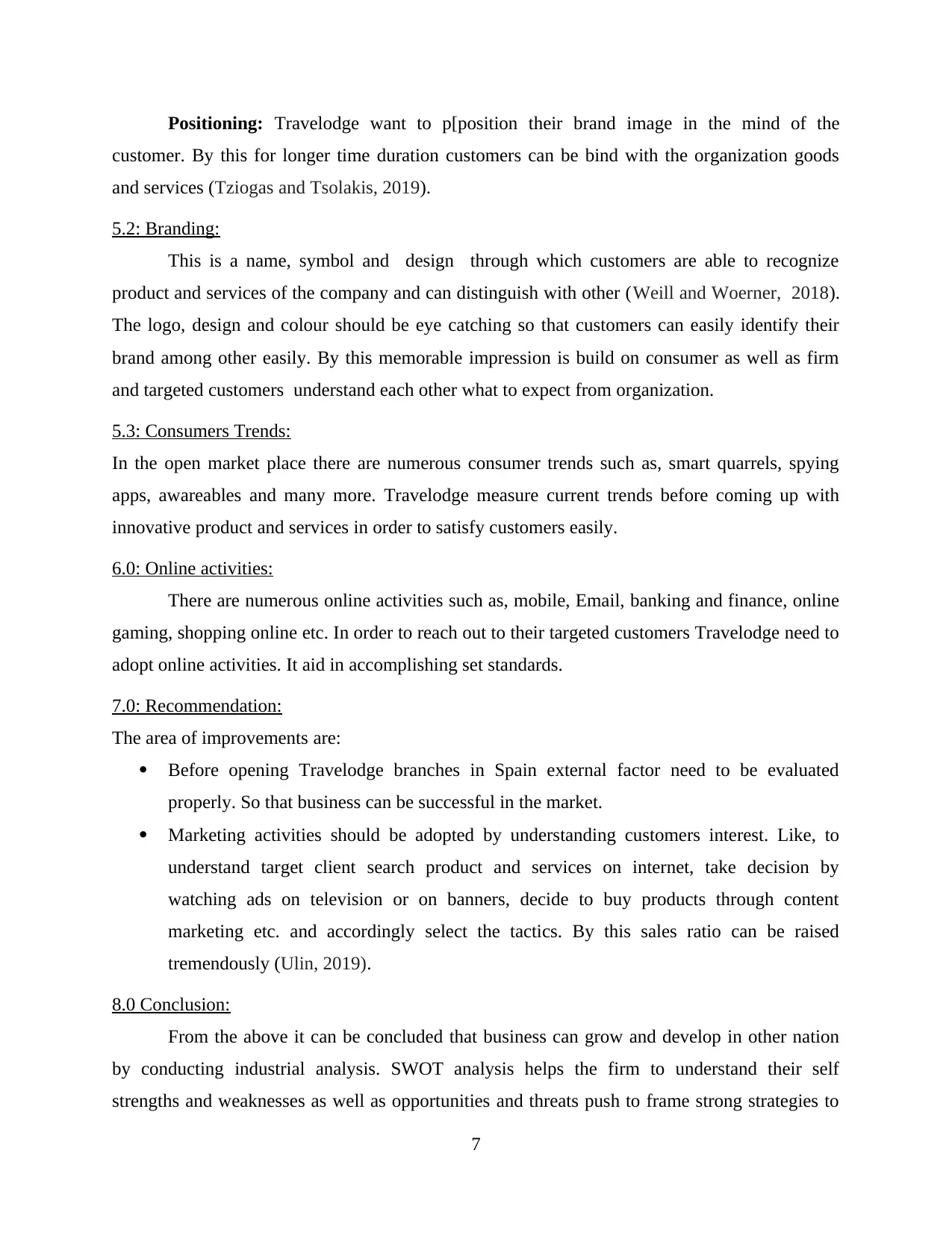
Positioning: Travelodge want to p[position their brand image in the mind of the
customer. By this for longer time duration customers can be bind with the organization goods
and services (Tziogas and Tsolakis, 2019).
5.2: Branding:
This is a name, symbol and design through which customers are able to recognize
product and services of the company and can distinguish with other (Weill and Woerner, 2018).
The logo, design and colour should be eye catching so that customers can easily identify their
brand among other easily. By this memorable impression is build on consumer as well as firm
and targeted customers understand each other what to expect from organization.
5.3: Consumers Trends:
In the open market place there are numerous consumer trends such as, smart quarrels, spying
apps, awareables and many more. Travelodge measure current trends before coming up with
innovative product and services in order to satisfy customers easily.
6.0: Online activities:
There are numerous online activities such as, mobile, Email, banking and finance, online
gaming, shopping online etc. In order to reach out to their targeted customers Travelodge need to
adopt online activities. It aid in accomplishing set standards.
7.0: Recommendation:
The area of improvements are:
Before opening Travelodge branches in Spain external factor need to be evaluated
properly. So that business can be successful in the market.
Marketing activities should be adopted by understanding customers interest. Like, to
understand target client search product and services on internet, take decision by
watching ads on television or on banners, decide to buy products through content
marketing etc. and accordingly select the tactics. By this sales ratio can be raised
tremendously (Ulin, 2019).
8.0 Conclusion:
From the above it can be concluded that business can grow and develop in other nation
by conducting industrial analysis. SWOT analysis helps the firm to understand their self
strengths and weaknesses as well as opportunities and threats push to frame strong strategies to
7
customer. By this for longer time duration customers can be bind with the organization goods
and services (Tziogas and Tsolakis, 2019).
5.2: Branding:
This is a name, symbol and design through which customers are able to recognize
product and services of the company and can distinguish with other (Weill and Woerner, 2018).
The logo, design and colour should be eye catching so that customers can easily identify their
brand among other easily. By this memorable impression is build on consumer as well as firm
and targeted customers understand each other what to expect from organization.
5.3: Consumers Trends:
In the open market place there are numerous consumer trends such as, smart quarrels, spying
apps, awareables and many more. Travelodge measure current trends before coming up with
innovative product and services in order to satisfy customers easily.
6.0: Online activities:
There are numerous online activities such as, mobile, Email, banking and finance, online
gaming, shopping online etc. In order to reach out to their targeted customers Travelodge need to
adopt online activities. It aid in accomplishing set standards.
7.0: Recommendation:
The area of improvements are:
Before opening Travelodge branches in Spain external factor need to be evaluated
properly. So that business can be successful in the market.
Marketing activities should be adopted by understanding customers interest. Like, to
understand target client search product and services on internet, take decision by
watching ads on television or on banners, decide to buy products through content
marketing etc. and accordingly select the tactics. By this sales ratio can be raised
tremendously (Ulin, 2019).
8.0 Conclusion:
From the above it can be concluded that business can grow and develop in other nation
by conducting industrial analysis. SWOT analysis helps the firm to understand their self
strengths and weaknesses as well as opportunities and threats push to frame strong strategies to
7
⊘ This is a preview!⊘
Do you want full access?
Subscribe today to unlock all pages.

Trusted by 1+ million students worldwide
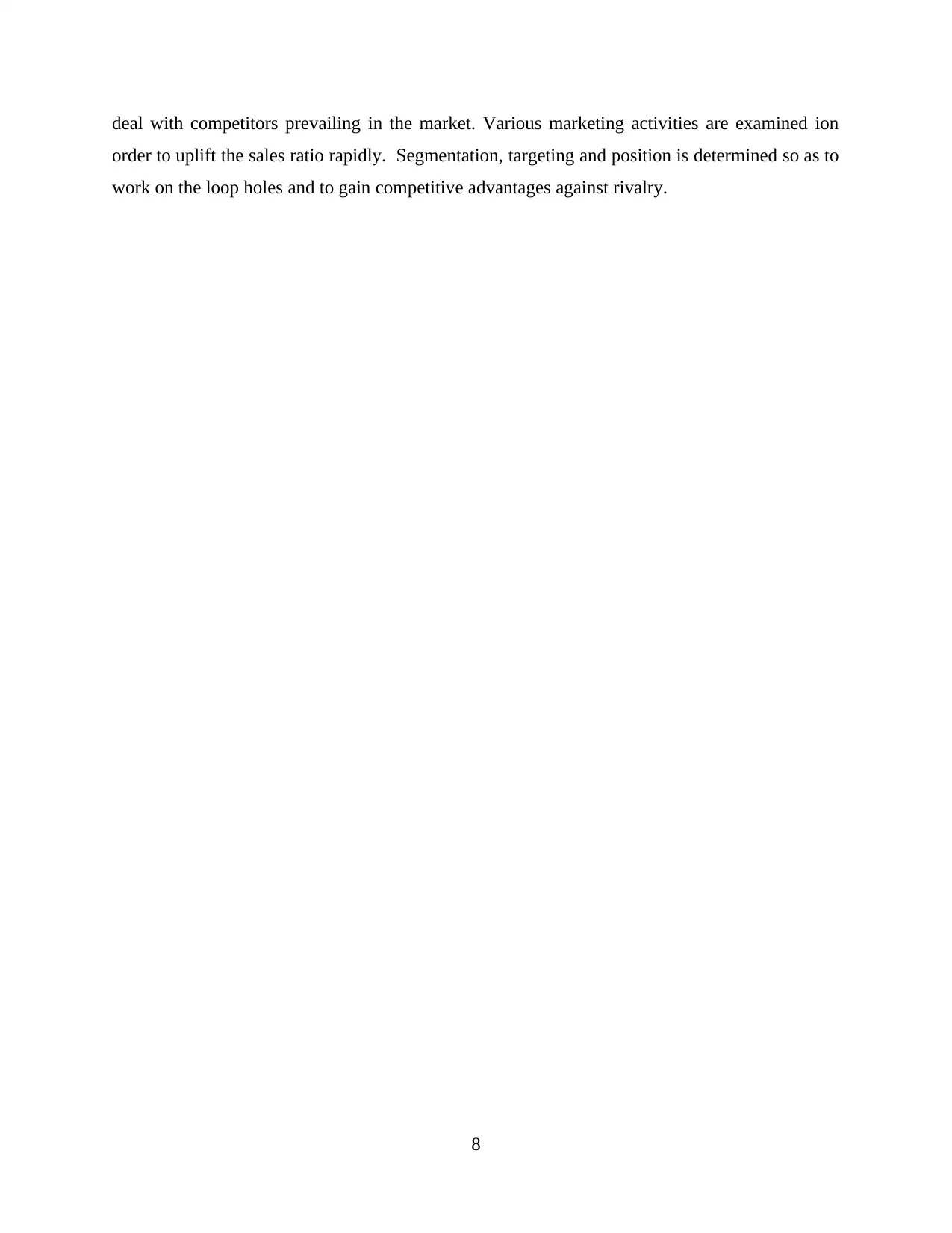
deal with competitors prevailing in the market. Various marketing activities are examined ion
order to uplift the sales ratio rapidly. Segmentation, targeting and position is determined so as to
work on the loop holes and to gain competitive advantages against rivalry.
8
order to uplift the sales ratio rapidly. Segmentation, targeting and position is determined so as to
work on the loop holes and to gain competitive advantages against rivalry.
8
Paraphrase This Document
Need a fresh take? Get an instant paraphrase of this document with our AI Paraphraser
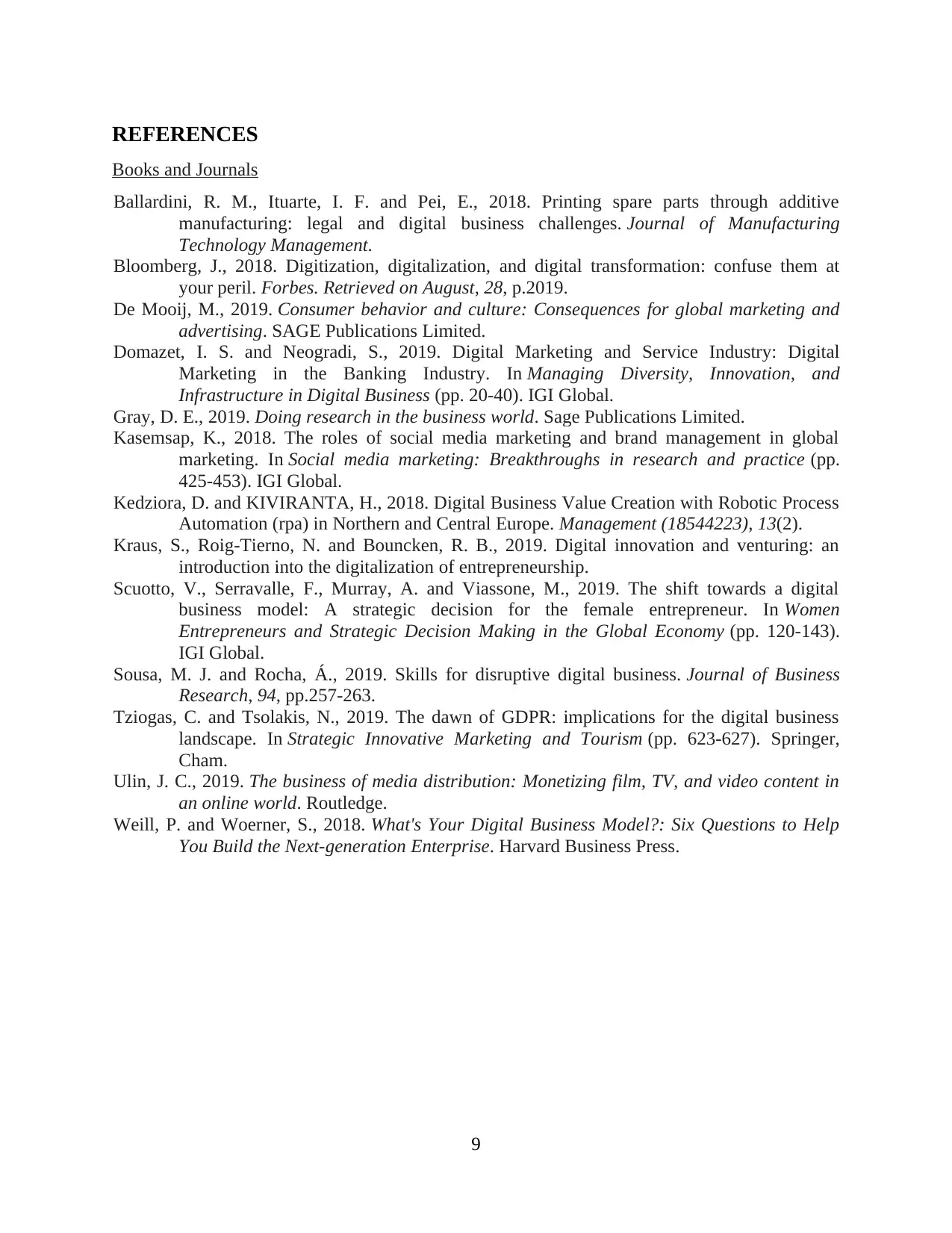
REFERENCES
Books and Journals
Ballardini, R. M., Ituarte, I. F. and Pei, E., 2018. Printing spare parts through additive
manufacturing: legal and digital business challenges. Journal of Manufacturing
Technology Management.
Bloomberg, J., 2018. Digitization, digitalization, and digital transformation: confuse them at
your peril. Forbes. Retrieved on August, 28, p.2019.
De Mooij, M., 2019. Consumer behavior and culture: Consequences for global marketing and
advertising. SAGE Publications Limited.
Domazet, I. S. and Neogradi, S., 2019. Digital Marketing and Service Industry: Digital
Marketing in the Banking Industry. In Managing Diversity, Innovation, and
Infrastructure in Digital Business (pp. 20-40). IGI Global.
Gray, D. E., 2019. Doing research in the business world. Sage Publications Limited.
Kasemsap, K., 2018. The roles of social media marketing and brand management in global
marketing. In Social media marketing: Breakthroughs in research and practice (pp.
425-453). IGI Global.
Kedziora, D. and KIVIRANTA, H., 2018. Digital Business Value Creation with Robotic Process
Automation (rpa) in Northern and Central Europe. Management (18544223), 13(2).
Kraus, S., Roig-Tierno, N. and Bouncken, R. B., 2019. Digital innovation and venturing: an
introduction into the digitalization of entrepreneurship.
Scuotto, V., Serravalle, F., Murray, A. and Viassone, M., 2019. The shift towards a digital
business model: A strategic decision for the female entrepreneur. In Women
Entrepreneurs and Strategic Decision Making in the Global Economy (pp. 120-143).
IGI Global.
Sousa, M. J. and Rocha, Á., 2019. Skills for disruptive digital business. Journal of Business
Research, 94, pp.257-263.
Tziogas, C. and Tsolakis, N., 2019. The dawn of GDPR: implications for the digital business
landscape. In Strategic Innovative Marketing and Tourism (pp. 623-627). Springer,
Cham.
Ulin, J. C., 2019. The business of media distribution: Monetizing film, TV, and video content in
an online world. Routledge.
Weill, P. and Woerner, S., 2018. What's Your Digital Business Model?: Six Questions to Help
You Build the Next-generation Enterprise. Harvard Business Press.
9
Books and Journals
Ballardini, R. M., Ituarte, I. F. and Pei, E., 2018. Printing spare parts through additive
manufacturing: legal and digital business challenges. Journal of Manufacturing
Technology Management.
Bloomberg, J., 2018. Digitization, digitalization, and digital transformation: confuse them at
your peril. Forbes. Retrieved on August, 28, p.2019.
De Mooij, M., 2019. Consumer behavior and culture: Consequences for global marketing and
advertising. SAGE Publications Limited.
Domazet, I. S. and Neogradi, S., 2019. Digital Marketing and Service Industry: Digital
Marketing in the Banking Industry. In Managing Diversity, Innovation, and
Infrastructure in Digital Business (pp. 20-40). IGI Global.
Gray, D. E., 2019. Doing research in the business world. Sage Publications Limited.
Kasemsap, K., 2018. The roles of social media marketing and brand management in global
marketing. In Social media marketing: Breakthroughs in research and practice (pp.
425-453). IGI Global.
Kedziora, D. and KIVIRANTA, H., 2018. Digital Business Value Creation with Robotic Process
Automation (rpa) in Northern and Central Europe. Management (18544223), 13(2).
Kraus, S., Roig-Tierno, N. and Bouncken, R. B., 2019. Digital innovation and venturing: an
introduction into the digitalization of entrepreneurship.
Scuotto, V., Serravalle, F., Murray, A. and Viassone, M., 2019. The shift towards a digital
business model: A strategic decision for the female entrepreneur. In Women
Entrepreneurs and Strategic Decision Making in the Global Economy (pp. 120-143).
IGI Global.
Sousa, M. J. and Rocha, Á., 2019. Skills for disruptive digital business. Journal of Business
Research, 94, pp.257-263.
Tziogas, C. and Tsolakis, N., 2019. The dawn of GDPR: implications for the digital business
landscape. In Strategic Innovative Marketing and Tourism (pp. 623-627). Springer,
Cham.
Ulin, J. C., 2019. The business of media distribution: Monetizing film, TV, and video content in
an online world. Routledge.
Weill, P. and Woerner, S., 2018. What's Your Digital Business Model?: Six Questions to Help
You Build the Next-generation Enterprise. Harvard Business Press.
9
1 out of 11
Related Documents
Your All-in-One AI-Powered Toolkit for Academic Success.
+13062052269
info@desklib.com
Available 24*7 on WhatsApp / Email
![[object Object]](/_next/static/media/star-bottom.7253800d.svg)
Unlock your academic potential
Copyright © 2020–2025 A2Z Services. All Rights Reserved. Developed and managed by ZUCOL.





